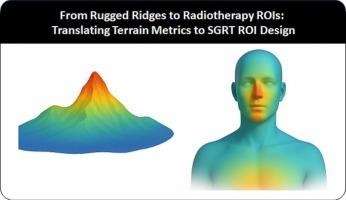从崎岖的山脊到放射治疗roi:将地形指标转化为放射治疗中感兴趣的表面引导放射治疗区域。
IF 5.3
1区 医学
Q1 ONCOLOGY
引用次数: 0
摘要
目的:评估地理衍生的地形指标(如坡度、坡向、高程变化和崎岖度)是否能定量、可重复地描述SGRT ROI表面质量。我们预先指定了可行性标准:(i)单调的、方向一致的变化,在合成表面上控制平滑;(ii)临床不同roi之间分布的分离(乳房大小;全脸vs窄脸)。方法:采用坡度、坡向、矢量崎岖度(VRM)、地形位置指数(TPI)和地形崎岖度指数(TRI)等定量地形指标进行调查。首先,在Python中使用柏林噪声生成合成的类胸和类脸表面。每个表面逐渐平滑,并分析了对表面复杂性的度量响应。其次,从AlignRT SGRT系统中导出三个表面捕获:小乳房、大乳房和人脸,对其进行裁剪以生成有限面部和全面部。直方图和3D地图可视化了每个ROI的度量分布。结果:坡度、坡向、TPI和TRI有效地捕获了合成数据和患者数据中的地表变化,为SGRT识别了有用的地形特征。相对于典型的崎岖地质地形,VRM仍然很低,表明光滑皮肤表面的价值有限。对于合成表面,增加了平滑压缩斜率值趋近于零,缩小了纵横差,降低了TRI/TPI变异性。对于患者/志愿者表面,小乳房ROI的斜率和纵横区域较少,而大乳房ROI的斜率和纵横范围更宽,TRI/TPI更高,反映出更明显的局部褶皱。全面roi的斜率/TRI/TPI范围比有限面roi更宽。结论:地理衍生指标量化ROI表面变化,满足预先指定的可行性标准,有助于个性化和优化个体患者解剖的ROI选择。这些结果为ROI设计和培训提供了定量基础;需要前瞻性研究将度量阈值与设置和内部性能联系起来。本文章由计算机程序翻译,如有差异,请以英文原文为准。

From rugged ridges to radiotherapy ROIs: Translating topographical metrics to Surface-Guided Radiation Therapy regions of Interest in radiotherapy
Purpose
To evaluate whether geography-derived topographical metrics (e.g., slope, aspect, elevation change and ruggedness) provide a quantitative, reproducible description of SGRT ROI surface quality. We pre-specified feasibility criteria: (i) monotonic, directionally consistent changes with controlled smoothing on synthetic surfaces; and (ii) separation of distributions between clinically distinct ROIs (breast size; full- vs limited-face).
Methods
Quantitative topographical metrics were identified for investigation including Slope, Aspect, Vector Ruggedness Measure (VRM), Topographic Position Index (TPI) and Terrain Ruggedness Index (TRI). First, synthetic breast-like and face-like surfaces were generated in Python using Perlin noise. Each surface was progressively smoothed and analysed for metric response to surface complexity. Second, three surface captures were exported from the AlignRT SGRT system: a small breast, a large breast and a face, which was cropped to produce a limited‐face and a full‐face surface. Histograms and 3D maps visualized metric distributions for each ROI.
Results
Slope, Aspect, TPI, and TRI effectively captured surface variations in both synthetic and patient data, identifying useful topographical features for SGRT. VRM remained low, relative to typical rugged geological terrain, indicating limited value for smooth skin surfaces. For the synthetic surfaces, increased smoothing compressed slope values toward zero, narrowed Aspect spreads, and lowered TRI/TPI variability. For patient/volunteer surfaces, the small-breast ROI showed fewer slope and aspect regions, and the large-breast ROI had broader slope and aspect ranges, and higher TRI/TPI, reflecting more pronounced local folds. Full‐face ROIs exhibited wider slope/TRI/TPI ranges than limited‐face ROIs.
Conclusion
Geography-derived metrics quantify ROI surface variation and meet pre-specified feasibility criteria and may help personalise and optimise ROI selection for individual patient anatomy. These results provide a quantitative foundation for ROI design and training; prospective studies are required to link metric thresholds to setup and intrafraction performance.
求助全文
通过发布文献求助,成功后即可免费获取论文全文。
去求助
来源期刊

Radiotherapy and Oncology
医学-核医学
CiteScore
10.30
自引率
10.50%
发文量
2445
审稿时长
45 days
期刊介绍:
Radiotherapy and Oncology publishes papers describing original research as well as review articles. It covers areas of interest relating to radiation oncology. This includes: clinical radiotherapy, combined modality treatment, translational studies, epidemiological outcomes, imaging, dosimetry, and radiation therapy planning, experimental work in radiobiology, chemobiology, hyperthermia and tumour biology, as well as data science in radiation oncology and physics aspects relevant to oncology.Papers on more general aspects of interest to the radiation oncologist including chemotherapy, surgery and immunology are also published.
 求助内容:
求助内容: 应助结果提醒方式:
应助结果提醒方式:


